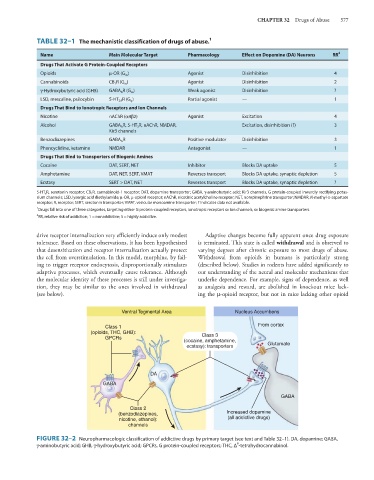Page 591 - Basic _ Clinical Pharmacology ( PDFDrive )
P. 591
CHAPTER 32 Drugs of Abuse 577
TABLE 32–1 The mechanistic classification of drugs of abuse. 1
Name Main Molecular Target Pharmacology Effect on Dopamine (DA) Neurons RR 2
Drugs That Activate G Protein-Coupled Receptors
Opioids μ-OR (G io ) Agonist Disinhibition 4
Cannabinoids CB 1 R (G io ) Agonist Disinhibition 2
γ-Hydroxybutyric acid (GHB) GABA B R (G io ) Weak agonist Disinhibition ?
LSD, mescaline, psilocybin 5-HT 2A R (G q ) Partial agonist — 1
Drugs That Bind to Ionotropic Receptors and Ion Channels
Nicotine nAChR (α4β2) Agonist Excitation 4
Alcohol GABA A R, 5-HT 3 R, nAChR, NMDAR, Excitation, disinhibition (?) 3
Kir3 channels
Benzodiazepines GABA A R Positive modulator Disinhibition 3
Phencyclidine, ketamine NMDAR Antagonist — 1
Drugs That Bind to Transporters of Biogenic Amines
Cocaine DAT, SERT, NET Inhibitor Blocks DA uptake 5
Amphetamine DAT, NET, SERT, VMAT Reverses transport Blocks DA uptake, synaptic depletion 5
Ecstasy SERT > DAT, NET Reverses transport Blocks DA uptake, synaptic depletion ?
5-HT x R, serotonin receptor; CB 1 R, cannabinoid-1 receptor; DAT, dopamine transporter; GABA, γ-aminobutyric acid; Kir3 channels, G protein-coupled inwardly rectifying potas-
sium channels; LSD, lysergic acid diethylamide; μ-OR, μ-opioid receptor; nAChR, nicotinic acetylcholine receptor; NET, norepinephrine transporter; NMDAR, N-methyl-d-aspartate
receptor; R, receptor; SERT, serotonin transporter; VMAT, vesicular monoamine transporter; ? indicates data not available.
1 Drugs fall into one of three categories, targeting either G protein-coupled receptors, ionotropic receptors or ion channels, or biogenic amine transporters.
2
RR, relative risk of addiction; 1 = nonaddictive; 5 = highly addictive.
drive receptor internalization very efficiently induce only modest Adaptive changes become fully apparent once drug exposure
tolerance. Based on these observations, it has been hypothesized is terminated. This state is called withdrawal and is observed to
that desensitization and receptor internalization actually protect varying degrees after chronic exposure to most drugs of abuse.
the cell from overstimulation. In this model, morphine, by fail- Withdrawal from opioids in humans is particularly strong
ing to trigger receptor endocytosis, disproportionally stimulates (described below). Studies in rodents have added significantly to
adaptive processes, which eventually cause tolerance. Although our understanding of the neural and molecular mechanisms that
the molecular identity of these processes is still under investiga- underlie dependence. For example, signs of dependence, as well
tion, they may be similar to the ones involved in withdrawal as analgesia and reward, are abolished in knockout mice lack-
(see below). ing the μ-opioid receptor, but not in mice lacking other opioid
Ventral Tegmental Area Nucleus Accumbens
Class 1 From cortex
(opioids, THC, GHB):
GPCRs Class 3
(cocaine, amphetamine,
ecstasy): transporters Glutamate
DA
GABA
GABA
Class 2
(benzodiazepines, Increased dopamine
nicotine, ethanol): (all addictive drugs)
channels
FIGURE 32–2 Neuropharmacologic classification of addictive drugs by primary target (see text and Table 32–1). DA, dopamine; GABA,
9
γ-aminobutyric acid; GHB, γ-hydroxybutyric acid; GPCRs, G protein-coupled receptors; THC, Δ -tetrahydrocannabinol.

